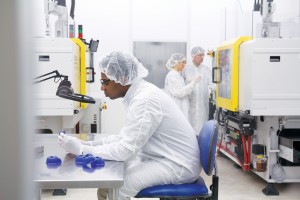As a new engineer at Apple Rubber, I recently attended a four-day liquid silicone rubber (LSR) course presented by Arburg. The experience provided valuable insights into our core manufacturing processes and opened my eyes to how much more there is to learn in this specialized field.
Background
Apple Rubber has pioneered the development and production of high-performance silicone components for diverse industrial applications, including medical devices, automotive systems, aerospace engineering, electronic assemblies and beyond. Since 1994, Apple Rubber has worked with liquid silicone rubber (LSR) which is primarily processed via injection molding. As a project engineer at Apple Rubber, my role allows me to be involved in all components of LSR processing.
Course Overview
The comprehensive training program covered all major aspects of LSR processing through presentations from the following industry leaders:
- Arburg (injection molding machines)
- Elmet (LSR pump systems)
- Elkem (LSR raw materials)
- M.R. Mold & Engineer Corp. (LSR mold making).
The course was designed for installation technicians, machine operators, mold designers, and process engineers, providing a well-rounded understanding of the entire LSR manufacturing ecosystem.
Key Learnings
Material Science
Starting with a liquid silicone presentation from Elkem, we dove into the chemistry of the material we work with. Derived from silica, LSR is a two-component system containing component A (a catalyst) and component B (an inhibitor), which typically mix to a 50:50 ratio and are cured via a polyaddition reaction.
The instructors emphasized the importance of achieving optimal cure time (T90) – the time it takes for the torque to reach 90% of its maximum achievable value during the vulcanization process. They also stressed the importance of proper pump meeting to get the correct ratio, as these factors directly impact product quality and consistency.
Equipment Design
Continuing with presentations from Elmet and M.R. Mold, we were introduced to tips and tricks for the equipment used on our injection molding machines. Both components are designed with the processability of LSR in mind.
We were given key indications and signs to look for on our pumping systems to ensure:
- Limited air bubbles
- Proper mixing of components A and B
- Minimal LSR pre-curing
- Proper maintenance protocols
Machine Operations
The Arburg portion of the training highlighted the methodology of programming, processing variables, warning signs, tips for optimizations, and maintenance of the machines. This was particularly new territory for me and provided great insight into the capabilities of these sophisticated systems.
During our hands-on time with the machines, we explored the cause-and-effect relationship of changing variables and how they affect the molded part and other parameters. We examined the impacts of adjusting:
- Injection speed
- Back pressure
- Clamping force
- Other critical variables
This better understanding of the different variables led us to producing quality parts and developing optimized injection programs. The practical experience complemented the classroom learning perfectly, allowing us to see the theoretical concepts in action.
Conclusion
Reflecting on the plethora of information that was presented during my four-day LSR course, it was incredibly insightful to hear from seasoned individuals in their respected fields. There are numerous helpful tips and ideas that will be beneficial to optimizing our rubber molding techniques at Apple Rubber.
Learning from experts across the LSR manufacturing ecosystem provided practical knowledge that will directly benefit our operations and allow us to continue delivering high-quality silicone components to our diverse customer base. As I continue to develop as an engineer in the rubber science and processing realm, the foundation built during this course will prove invaluable.
